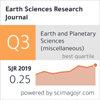基于人工神经网络(RBFNN和GRNN)、多元线性回归(MLR)和插值方法的大地水准面波动预测比较研究
IF 0.5
4区 地球科学
Q4 GEOSCIENCES, MULTIDISCIPLINARY
引用次数: 1
摘要
本工作旨在开发一个估计大地水准面起伏的预测模型,并将其与其他方法进行比较,包括径向基函数神经网络(RBFNN)、广义回归神经网络(GRNN)、多元线性回归(MLR)和十种不同的插值方法。在这项研究中,使用k倍交叉验证方法来评估模型及其在独立数据集上的行为。使用这种验证方法,k组中的每一组都有机会被划分为训练和测试数据。根据均方根误差(RMSE)、平均绝对误差(MAE)、纳什-萨克利夫效率系数(NSE)和相关系数(R2)并使用图形指标评估了这些方法的性能。通过两种方式对使用交叉验证获得的数据集的性能进行了评估。如果我们接受误差结果最小的方法作为最合适的方法,那么DS#5数据集中的自然邻居(NN)方法比其他方法给出了更好的结果(RMSE=0.414173 m,MAE=0.09729 m,NSE=0.8986,R2=0.99911)。另一方面,已经观察到,GRNN方法表现出最佳性能,平均而言,RMSE=0.18539 m,MAE=0.13676 m,NSE=0.98229,并且R2=0.98249。本文章由计算机程序翻译,如有差异,请以英文原文为准。
Geoid undulation prediction using ANNs (RBFNN and GRNN), multiple linear regression (MLR), and interpolation methods: A comparative study
The present work aimed to develop a prediction model to estimate geoid undulation and to compare its efficiency with other methods including radial basis function neural network (RBFNN), generalized regression neural network (GRNN), multiple linear regression (MLR) and, ten different interpolation methods. In this study, the k-fold cross-validation method was used to evaluate the model and its behavior on the independent dataset. With this validation method, each of a k number of groups has the chance to be divided into training and testing data. The performances of the methods were evaluated in terms of the root mean square error (RMSE) mean absolute error (MAE), Nash–Sutcliffe efficiency coefficient (NSE), and correlation coefficient (R2) and using graphical indicators. The evaluation of the performance of the datasets obtained using cross-validation was done in two ways. If we accept the method having the minimum error result as the most appropriate method, the natural neighbor (NN) method in the DS#5 dataset gave better results than the other methods (RMSE=0.14173 m, MAE=0.09729 m, NSE=0.98986, and R2=0.99011. On the other hand, it has been observed that, the GRNN method exhibited the best performance, on average, with RMSE=0.18539 m, MAE=0.13676 m, NSE=0.98229, and R2=0.98249.
求助全文
通过发布文献求助,成功后即可免费获取论文全文。
去求助
来源期刊

Earth Sciences Research Journal
地学-地球科学综合
CiteScore
1.50
自引率
0.00%
发文量
0
审稿时长
>12 weeks
期刊介绍:
ESRJ publishes the results from technical and scientific research on various disciplines of Earth Sciences and its interactions with several engineering applications.
Works will only be considered if not previously published anywhere else. Manuscripts must contain information derived from scientific research projects or technical developments. The ideas expressed by publishing in ESRJ are the sole responsibility of the authors.
We gladly consider manuscripts in the following subject areas:
-Geophysics: Seismology, Seismic Prospecting, Gravimetric, Magnetic and Electrical methods.
-Geology: Volcanology, Tectonics, Neotectonics, Geomorphology, Geochemistry, Geothermal Energy, ---Glaciology, Ore Geology, Environmental Geology, Geological Hazards.
-Geodesy: Geodynamics, GPS measurements applied to geological and geophysical problems.
-Basic Sciences and Computer Science applied to Geology and Geophysics.
-Meteorology and Atmospheric Sciences.
-Oceanography.
-Planetary Sciences.
-Engineering: Earthquake Engineering and Seismology Engineering, Geological Engineering, Geotechnics.
 求助内容:
求助内容: 应助结果提醒方式:
应助结果提醒方式:


